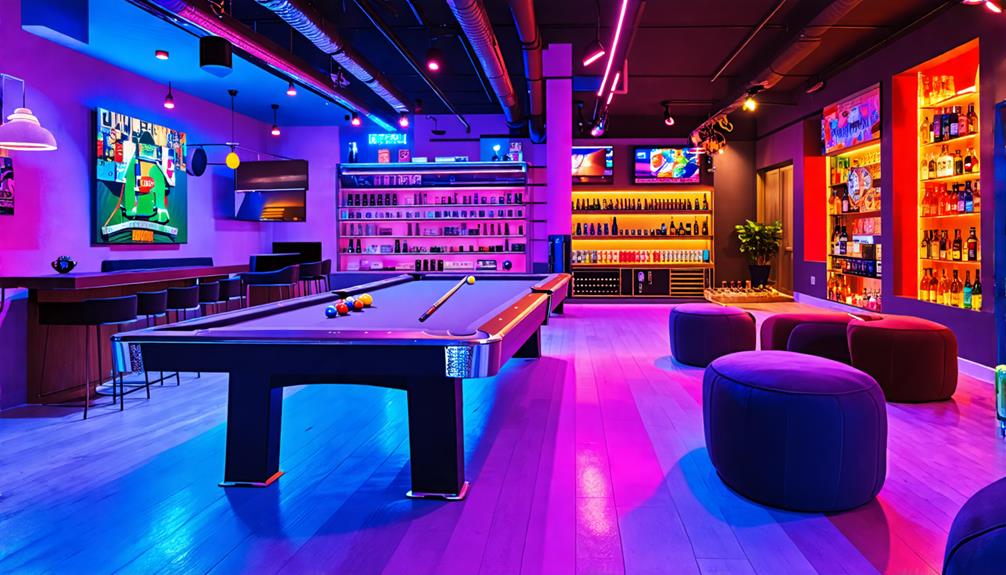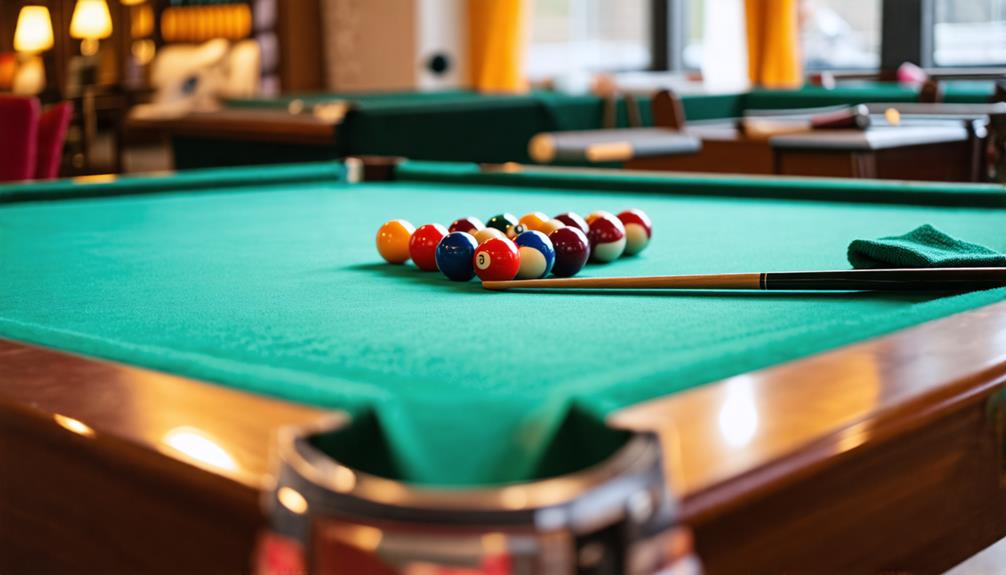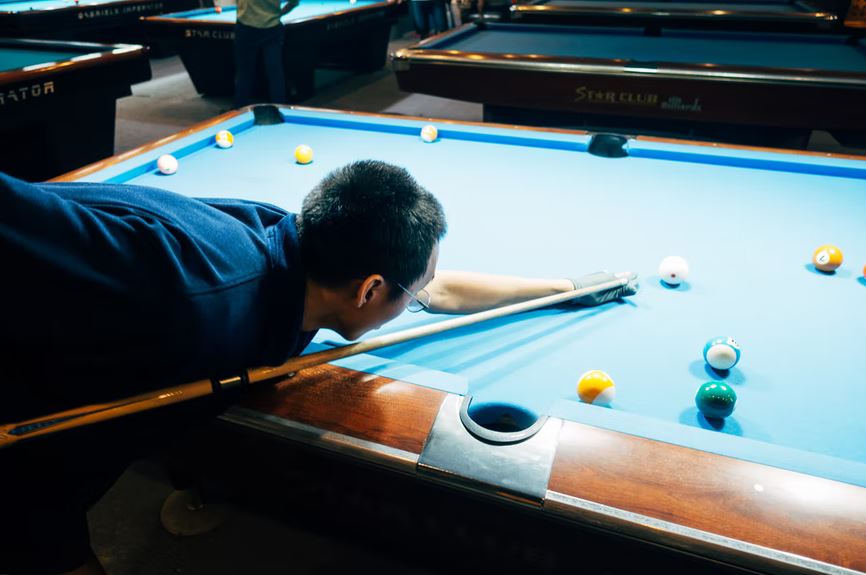How to Choose the Perfect Pool Table for Your Home
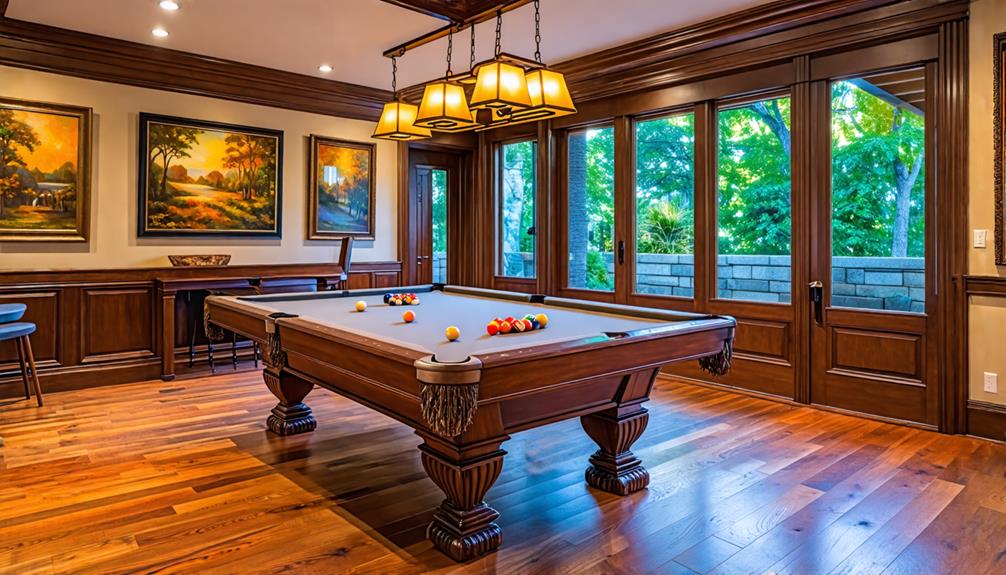
Choosing the perfect pool table for your home starts with a clear understanding of your space and needs. Measure the area to ensure you have enough room for both the table and comfortable movement around it. Once you have your measurements, consider the type of table that fits your style and usage. However, this is just the beginning. There are several vital features and considerations that can greatly affect your playing experience and overall satisfaction.
Prioritize the following factors to make the best choice:
- Table Size: Ensure the table fits well within your space without crowding the room.
- Material Quality: Invest in high-quality materials for durability and better gameplay.
- Cushion and Slate: Look for tables with high-quality cushions and slates for a consistent playing surface.
- Aesthetic Appeal: Choose a design that complements your home decor.
- Budget: Set a budget and try to find the best table within your price range.
- Usage Frequency: Consider how often the table will be used and by whom.
By focusing on these factors, you'll be better equipped to choose a pool table that enhances both your home and your playing experience.
Types of Pool Tables
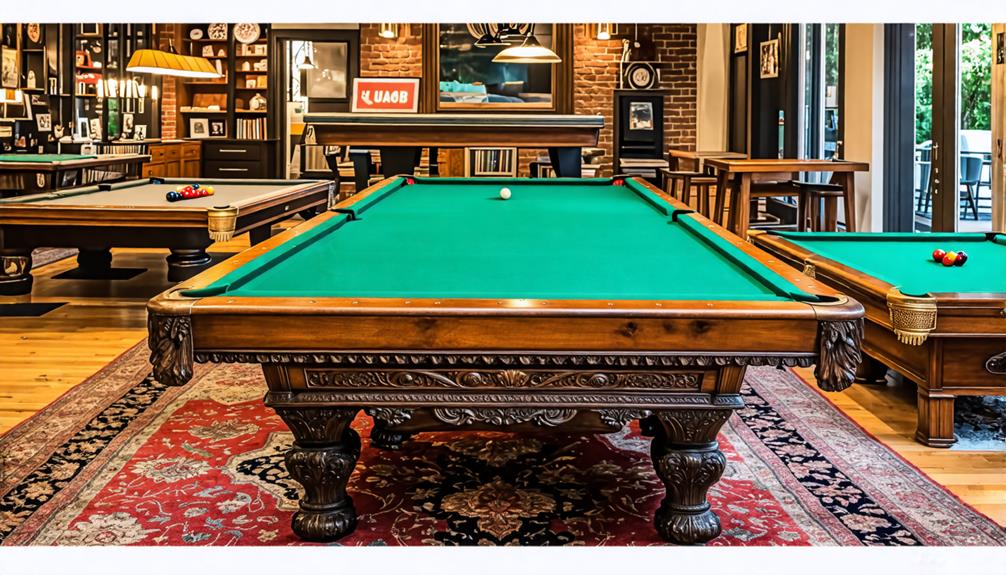
When choosing a pool table, it's essential to understand the different types available to find the one that best fits your space and gameplay needs. The Classic/Standard Pool Tables are the traditional choice, featuring wooden bases and felt tops, making them a great enhancement to any game room.
For versatility, consider Multi-Purpose Tables that can transform into air hockey or dining tables, ideal for families or smaller spaces. For those with limited room, Compact Pool Tables are smaller than standard sizes but still provide a full gameplay experience, making them perfect for apartments or small game areas. If you need something you can easily transport, Portable Pool Tables offer a collapsible design, allowing for convenient storage and casual play wherever you go.
Key Features to Consider
Choosing the right pool table involves evaluating key features that impact the quality of gameplay and the overall experience. First, consider the playing surface. Opt for a slate surface for superior smoothness and durability, with a recommended thickness of 1 inch for tournament play.
Next, assess the frame construction. Solid hardwood or quad-frame designs offer greater stability and protect the slate from long-term damage. Cushion quality is another critical factor; K66 rubber cushions provide optimal bounce and responsiveness, enhancing gameplay.
The type of pockets also affects your experience. Drop pockets offer convenience, while corner pockets provide a traditional feel that impacts ball retrieval and play style. Finally, examine the leg design. Single-piece wooden legs offer superior support and stability, while adjustable legs ensure a level playing surface, preventing wobbling during play.
Understanding Pool Table Sizes
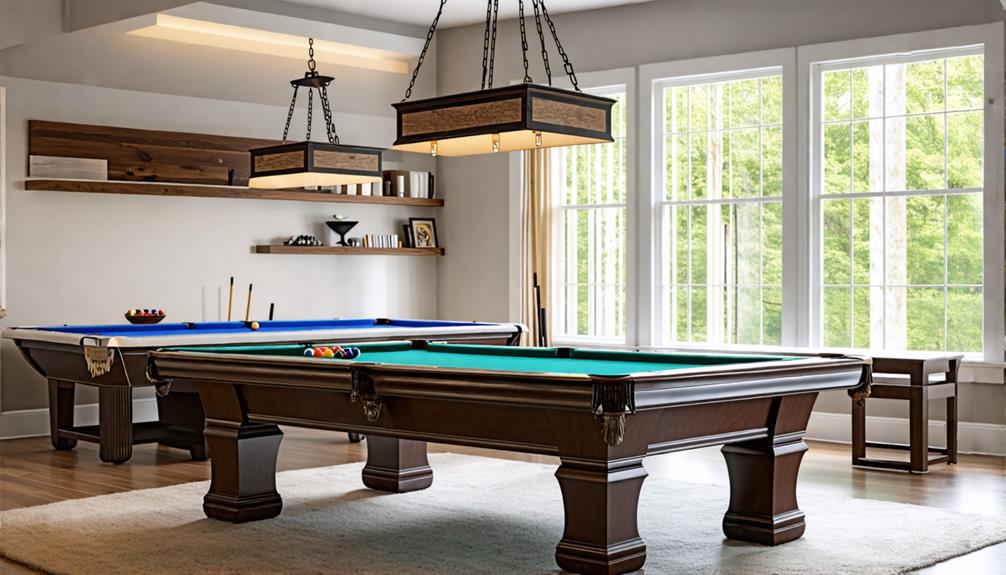
Understanding pool table sizes is crucial for selecting the right fit for your space and gameplay needs. Standard pool table sizes include 7-foot, 8-foot, and 9-foot tables, with the 8-foot model being the most common for home use. A regulation-size pool table typically measures 44 inches wide by 88 inches long, adhering to a 2:1 length-to-width ratio.
When choosing a size, first consider your room dimensions. You need about 4 feet of clearance around the table for cueing and movement. This space allows for comfortable play without feeling cramped. If your room is limited in size, smaller tables, such as those measuring 6 feet or less, can still provide an enjoyable gameplay experience without overwhelming the area.
Conversely, if you have ample space, you might consider larger options, like a 12-foot table, though it requires significant room for comfortable play. Ultimately, choosing the right pool table size enhances both your enjoyment and your playing space.
Pricing and Budgeting
When choosing a pool table, it's important to understand the price range: quality tables typically start around $2,000, while entry-level options can be as low as $500. Be sure to consider hidden costs such as accessories and maintenance, which can quickly add up. Setting a realistic budget now will help you enjoy your table for years to come without unexpected financial surprises.
Price Range Overview
Investing in a pool table requires navigating a spectrum of prices, from budget-friendly options to high-end models tailored to serious players. Entry-level pool tables start at around $500 but may compromise on quality and durability. For a better playing experience, consider slate tables priced around $2,000, which offer enhanced performance and longevity.
High-end models can exceed $5,000, featuring premium materials and advanced designs, ideal for avid players and collectors. Additionally, factor in extra costs for accessories like cues, balls, and maintenance, as well as installation fees.
Many retailers offer financing options or payment plans, making it easier to invest in a quality pool table without the burden of immediate full payment. By understanding the price range and considering your budget, you can make an informed decision that suits your needs and lifestyle. Choose wisely, and you'll enjoy countless hours of fun with your new table!
Hidden Costs Consideration
While you may have a good understanding of the price range for pool tables, it's crucial to consider the hidden costs that can affect your total budget. High-quality slate tables typically start around $2,000, but you should also account for accessories and installation, which can add up quickly.
If you're considering entry-level tables priced at $500, be aware that opting for cheaper materials may compromise quality and durability. Maintenance costs are another factor to consider. Regular upkeep, such as felt replacement and cleaning supplies, can accumulate over time, impacting your overall expenses.
Additionally, many retailers offer financing options to help manage the upfront costs, but these may come with extra interest charges in the long run. Lastly, warranty coverage varies by manufacturer. A longer warranty often indicates better quality and can reduce hidden costs related to repairs or replacements.
Maintenance and Care
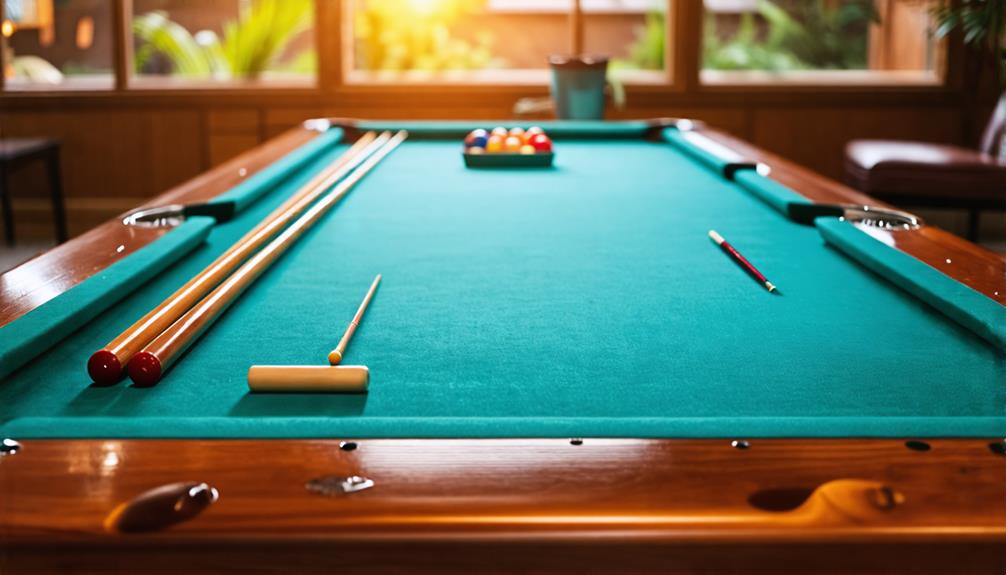
To maintain your pool table in optimal condition, regular cleaning is essential. Frequently check and adjust the leveling to ensure a fair game. Proper care of the felt and pockets will extend the table's lifespan and enhance your playing experience.
Regular Cleaning Practices
Regular cleaning practices are essential for maintaining your pool table's quality and ensuring an enjoyable gameplay experience. By adopting a simple routine, you can keep your table in top shape for years to come.
| Cleaning Task | Frequency | Purpose |
|---|---|---|
| Dust the felt | Weekly | Maintain quality of play surface |
| Vacuum the table | Monthly | Remove debris without damaging fabric |
| Clean the balls | After each session | Preserve finish and gameplay |
| Use a table cover | Daily | Protect from dust and spills |
To start, use a soft brush to gently remove dust from the felt. Vacuum the table with a low-suction setting to avoid damaging the fabric. Clean the balls with a damp cloth after each session to remove dirt and oils. Regularly inspect the felt and replace it if you notice signs of wear to ensure a smooth play surface. Finally, always use a table cover when the table is not in use; this simple step can greatly extend its lifespan, keeping your pool table looking and performing its best.
Leveling and Adjustments
Maintaining a level pool table is essential for accurate gameplay and overall enjoyment. To achieve this, regularly check the level of your table using a level tool. Ensuring a perfectly level surface prevents inconsistencies that can disrupt your playing experience. If you find any unevenness, adjust the table's legs as needed to make certain all four corners are even and stable.
Over time, you might notice signs of wear, such as sagging pockets or stretched felt. Periodic adjustments can help maintain optimal playing conditions. If your floor is uneven, consider using adjustable leg pads or shims to stabilize the table and prevent wobbling.
Routine inspections are crucial for catching and addressing issues early on. Prompt attention to signs of wear can prolong the life of your table and ensure it remains enjoyable for years. Actively maintaining the leveling and making necessary adjustments will create a consistent and enjoyable playing surface for you and your guests. By following these steps, you can enhance your playing experience and keep your pool table in top condition.
Felt and Pocket Care
Proper care for the felt and pockets of your pool table ensures a smooth playing experience and extends the life of your equipment. Regular maintenance is essential to keep your table in optimal condition. Here are three crucial steps to follow:
- Clean the Felt: Use a soft brush and vacuum to regularly remove dust and debris from the felt. This simple act can significantly prolong its lifespan and enhance play quality.
- Inspect for Wear: Regularly check the felt for signs of wear such as discoloration or pilling. Promptly replace the felt if you notice any issues to maintain a smooth playing surface.
- Protect the Pockets: Monitor your pockets for any tears or signs of wear. Repair or replace them as needed to ensure proper ball return and avoid interruptions during gameplay.
Additionally, always use a table cover when your pool table isn't in use to protect the felt and pockets from dust, spills, and potential damage. Maintaining consistent humidity and temperature levels in the room also helps prevent the felt and wood from warping.
Aesthetics and Design
When selecting a pool table, it's important to consider how its design and aesthetics will enhance your home's overall style. Opt for classic designs with hardwood frames and traditional felt colors like green or red for a timeless appearance. These options seamlessly complement various home styles, adding a sophisticated touch.
For a contemporary decor, explore pool tables with modern finishes and a variety of felt colors. This customization allows you to enhance your game room's aesthetic, reflecting your personal taste. Innovative designs, such as unique leg structures or built-in LED lighting, can serve as striking focal points in any entertainment space. Consider multifunctional pieces like pool dining tables, which combine a playable surface with a functional dining area. These tables maintain visual harmony without sacrificing style, making them ideal for smaller spaces.
Preparing to Purchase
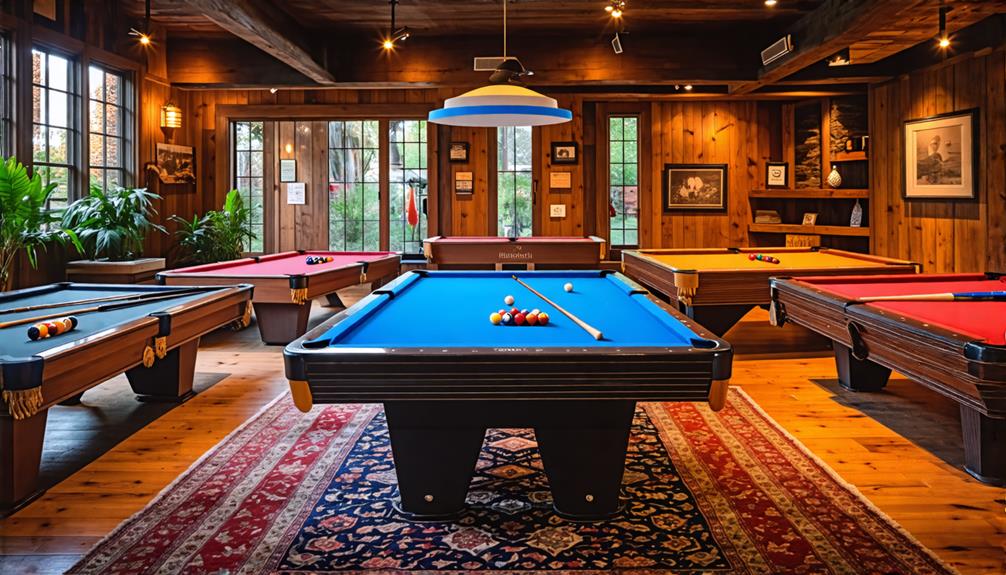
Before purchasing a pool table, it's essential to assess your available space and budget to ensure a perfect fit for your home.
Here's a concise Pool Table Buying Guide to help you prepare:
- Measure Your Space: Ensure you have adequate room dimensions for comfortable gameplay. Ideally, leave at least 1.22m (4ft) clearance around the table. For reference, a 7-foot table generally requires about 13 x 17 feet, while an 8-foot table needs approximately 14 x 18 feet.
- Set Your Budget: Determine your budget range. Quality slate tables typically start around $2,000, while entry-level options can be found for about $500. Knowing your budget helps narrow down your choices effectively.
- Consider Features: Decide on the desired features, such as size, material, and style. These elements will impact both your gameplay experience and how well the table integrates with your home decor.
Conclusion
In summary, choosing the perfect pool table for your home involves balancing space, style, and functionality. Consider the types, sizes, and key features to find a table that meets your needs and enhances your space. Factor in your budget and maintenance requirements to ensure long-term enjoyment. With proper preparation, you can make a purchase that elevates your game and complements your home decor. Happy playing!
